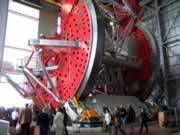
Astrophysicists from the University of Notre Dame recently attended dedication ceremonies for the Large Binocular Telescope (LBT), a scientific achievement that promises to provide unparalleled views of the universe.
The $120 million LBT is located atop Mount Graham, a 10,700-foot mountain near Safford, in southwest Arizona. When fully operational in 2005, it will be the most technologically advanced ground-based telescope in the world.
Ani Aprahamian, professor and chair of physics; Mitchell Wayne, professor of physics and associate dean of the College of Science; and Terrence Rettig, professor of physics, represented the University at the dedication. Notre Dames contributions to the project entitle its astrophysicists to 10 observing nights per year, a significant amount of time on the worlds largest optical telescope on a single mount.
The LBT is unlike any other telescope because it utilizes twin 8.4-meter (27.6-foot) “honeycomb” mirrors that sit on a single mount, allowing it to simulate a 23-meter telescope. At this stage in its development, only one of the LBTs mirrors is in place; the other is being polished and installation is anticipated by the middle of next year.
The LBT also will be equipped with “adaptive optics secondary mirrors,” which correct in real time for atmospheric turbulence that distorts starlight and results in image blurring. This results in much sharper images and allows astronomers to see objects deeper in space. Even sharper images can be obtained by combining the light from the two primary mirrors in the so-called “interferometric imaging” mode, which will yield images of faint celestial objects that will be 10 times sharper than those from the Hubble Space Telescope.
The LBT was built by a consortium with University of Arizona, German and Italian researchers each contributing a quarter of the funding and Ohio State University and Research Corp. making up the rest. Research Corp., established in 1912 to promote the advancement of science in the United States, facilitated the participation of Ohio State, Notre Dame, the University of Minnesota and the University of Virginia in the project.
TopicID: 7984